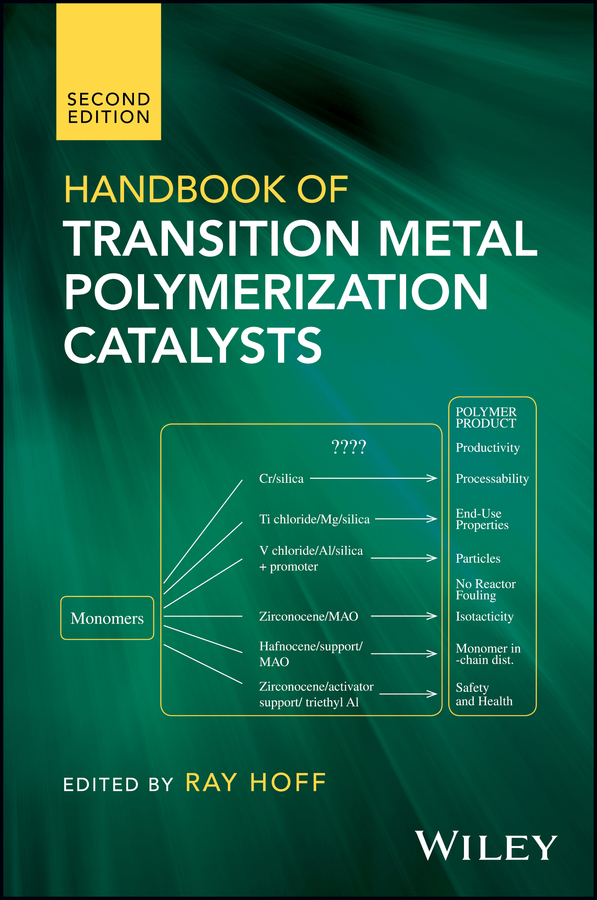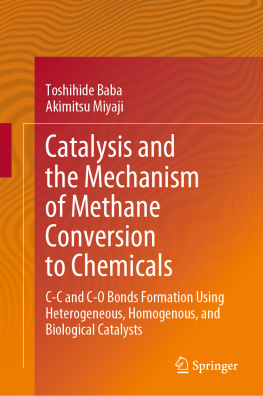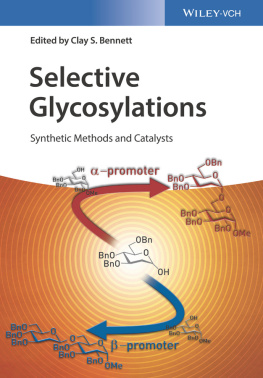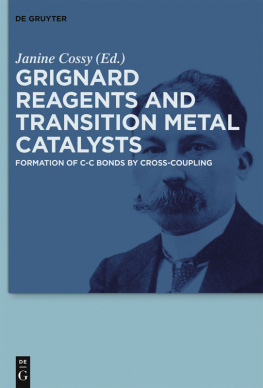
Table of Contents
List of Tables
- Chapter 01
- Chapter 02
- Chapter 05
- Chapter 08
- Chapter 10
- Chapter 11
- Chapter 12
- Chapter 13
- Chapter 14
- Chapter 16
- Chapter 17
- Chapter 18
- Appendix 01
List of Illustrations
- Chapter 01
- Chapter 02
- Chapter 03
- Chapter 04
- Chapter 05
- Chapter 06
- Chapter 07
- Chapter 08
- Chapter 09
- Chapter 10
- Chapter 11
- Chapter 12
- Chapter 13
- Chapter 14
- Chapter 15
- Chapter 16
- Chapter 17
- Chapter 18
- Appendix 01
Guide
Pages
Handbook of Transition Metal Polymerization Catalysts
Second Edition
Edited by Ray Hoff
Chemplex Company
Rolling Meadows, IL (retired)
This edition first published 2018
2018 John Wiley & Sons, Inc.
Edition History
Handbook of Transition Metal Polymerization Catalysts, Wiley, 2010
All rights reserved. No part of this publication may be reproduced, stored in a retrieval system, or transmitted, in any form or by any means, electronic, mechanical, photocopying, recording or otherwise, except as permitted by law. Advice on how to obtain permission to reuse material from this title is available at http://www.wiley.com/go/permissions.
The right of Ray Hoff to be identified as the editor of the editorial material in this work has been asserted in accordance with law.
Registered Office
John Wiley & Sons, Inc., 111 River Street, Hoboken, NJ 07030, USA
Editorial Office
111 River Street, Hoboken, NJ 07030, USA
For details of our global editorial offices, customer services, and more information about Wiley products visit us at www.wiley.com.
Wiley also publishes its books in a variety of electronic formats and by printondemand. Some content that appears in standard print versions of this book may not be available in other formats.
Limit of Liability/Disclaimer of Warranty
In view of ongoing research, equipment modifications, changes in governmental regulations, and the constant flow of information relating to the use of experimental reagents, equipment, and devices, the reader is urged to review and evaluate the information provided in the package insert or instructions for each chemical, piece of equipment, reagent, or device for, among other things, any changes in the instructions or indication of usage and for added warnings and precautions. While the publisher and authors have used their best efforts in preparing this work, they make no representations or warranties with respect to the accuracy or completeness of the contents of this work and specifically disclaim all warranties, including without limitation any implied warranties of merchantability or fitness for a particular purpose. No warranty may be created or extended by sales representatives, written sales materials or promotional statements for this work. The fact that an organization, website, or product is referred to in this work as a citation and/or potential source of further information does not mean that the publisher and authors endorse the information or services the organization, website, or product may provide or recommendations it may make. This work is sold with the understanding that the publisher is not engaged in rendering professional services. The advice and strategies contained herein may not be suitable for your situation. You should consult with a specialist where appropriate. Further, readers should be aware that websites listed in this work may have changed or disappeared between when this work was written and when it is read. Neither the publisher nor authors shall be liable for any loss of profit or any other commercial damages, including but not limited to special, incidental, consequential, or other damages.
Library of Congress CataloginginPublication Data
Names: Hoff, Raymond E., editor.
Title: Handbook of transition metal polymerization catalysts / edited by Ray Hoff.
Description: Second edition. | Hoboken, NJ : John Wiley & Sons, 2018. | Includes bibliographical references and index. |
Identifiers: LCCN 2017050314 (print) | LCCN 2017054609 (ebook) | ISBN 9781119242154 (pdf) | ISBN 9781119242215 (epub) | ISBN 9781119242130 (cloth)
Subjects: LCSH: Polymerization. | Transition metal catalysts. | Metathesis (Chemistry)
Classification: LCC QD281.P6 (ebook) | LCC QD281.P6 H295 2018 (print) | DDC 668.9/2dc23
LC record available at https://lccn.loc.gov/2017050314
Cover Design: Wiley
Cover Image: (Background) troyek/Gettyimages; (Diagram) Courtesy of Ray Hoff
Notes on Contributors
Timo M. J. Anselment was born in Berlin in 1981, studied chemistry at the Technische Universitt Mnchen, and obtained his diploma grade at the Chair of Macromolecular Chemistry of Prof. Oskar Nuyken under the supervision of Ph.D. Dr. Rainer Jordan in 2006. He joined the staff of Prof. Bernhard Rieger in 2007 at the WACKER Chair of Macromolecular Chemistry and works on his Ph.D. thesis about phosphinesulfonate complexes for alkene/CO copolymerizations.
Islem Belaid is a Ph.D. student in the Chemistry, Catalysis, Polymers and Processes laboratory (C2P2) at the Universit Claude Bernard Lyon 1 in France. She holds an engineers degree in analytical chemistry and instrumentation of the Faculty of Sciences of Tunis and a masters degree in innovative materials from the National Institute of Applied Sciences of Lyon. Her doctoral work focuses on the catalytic polymerization of olefins and conjugated dienes. Her search moves through and between the homogeneous catalysis of (co)polymerization of olefins (and dienes), the copolymerization of ethylene with olefins by supported metallocene catalysts, and the characterization of the resulting high performance materials by advanced techniques. Through these areas, she seeks to define the link between the catalyst structure and the obtained materials as well as to understand the structureproperty relationship of the polymers.
Christophe Boisson studied chemistry at the Ecole Nationale Suprieure de Chimie de Montpellier (France). He received his Ph.D. in Organic Chemistry from the University of ParisSud 11 in 1996 for investigations of the chemistry of fmetal amide complexes. The same year, he became research associate at the French National Center for Scientific Research (CNRS), and he joined the group of Dr. Roger Spitz at CPELyon where he developed researches in the field of copolymerization of ethylene with butadiene. In 2008, he was appointed CNRS research director at the laboratory of Chemistry, Catalysis, Polymers and Processes (C2P2). He is the group leader of the team Chemistry and Processes of Polymerization and the director of Laboratory of Innovation, Scaleup, and Intensification of Polymerization processes (LISIP joint C2P2/Activation). He has coauthored 90 publications including review papers and book chapters and has filed 23 patents. His research interests are focused on homogeneous and heterogeneous catalysts for the polymerization of olefins.
Kevin Cann received his Ph.D. from the University of Texas at Austin. He joined Union Carbide Corporation in 1979 working in the polyolefins catalyst area. Since the merger with the Dow Chemical Company (2001), he has worked for Univation Technologies, which continues to license UnipolTM gasphase polyethylene technology worldwide. His research areas have included development of ZieglerNatta, chromium, and singlesite catalysts for production of LLDPE, HDPE, EPDM, and polybutadiene polymers in the fluidbed gasphase process. He has over 35 US patents and more than 30 publications and papers. Dr.Cann currently is a consultant for the polyolefin industry based in Florida.
Next page







